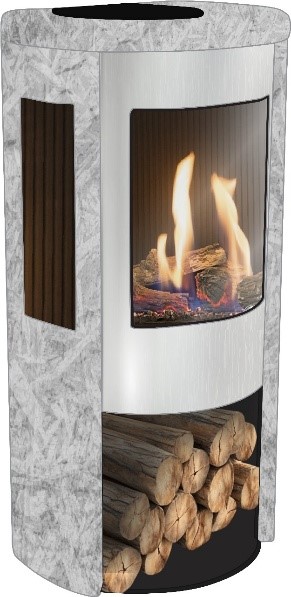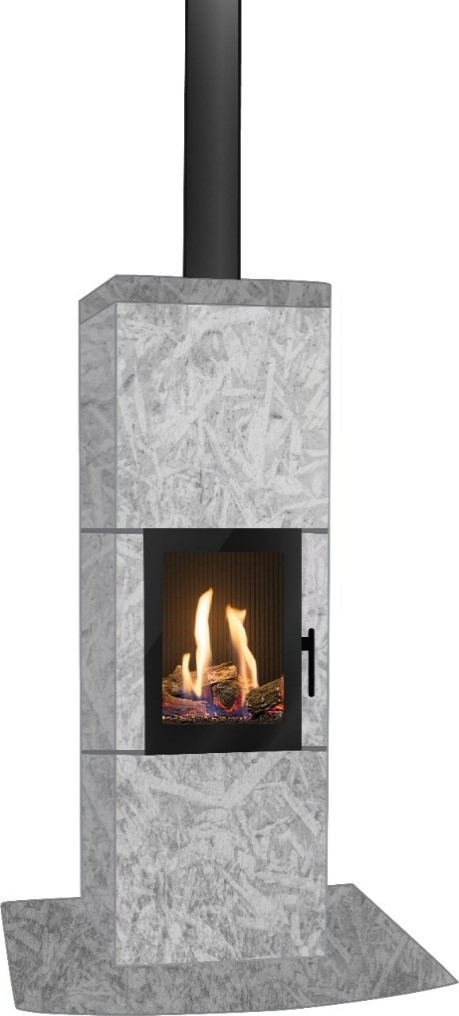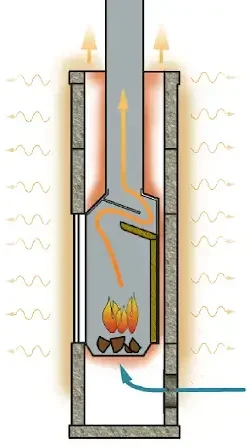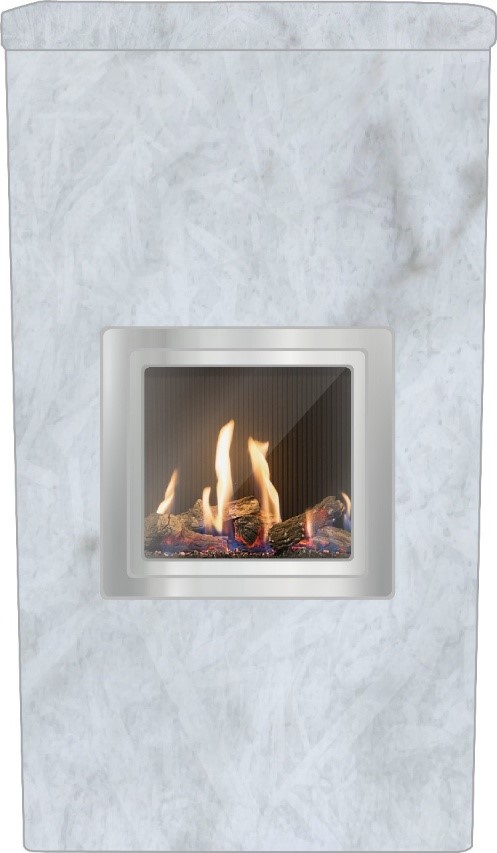Lookalike Soapstone Stoves
There are many stoves on the market with soapstone. These work quite differently and do not possess the heat storage and radiant heat capabilities that our stoves are known for. Below, we’ll show you a few typical examples. We’ve made the examples unrecognizable because we don’t want to name specific products and producers. While these products can certainly serve a good purpose depending on needs and budget, they are not good heat-accumulating stoves!

Many European producers, and some US manufacturers, offer stoves with soapstone. It’s also called a soapstone stove, but it’s genuinely different from a true soapstone stove. This type of stove stores a very small portion of the heat. It’s simply a convection stove with some soapstone for aesthetic purposes. Unfortunately, some manufacturers still advertise the good heat storage of soapstone. This is a shame because it misleads customers. Such a stove provides a maximum of 20% of the heat storage compared to a true soapstone stove like the ones we offer.
The stove in this unrecognizable photo is a typical “lookalike.” Such stoves are often only recognizable as “lookalikes” even by experts by examining their internal structure. The interior is genuinely different. There’s a metal frame that encloses the combustion chamber. This steel casing is cooled by the air circulating around it. So, there’s air between the stones and the steel frame. The warm air rises through a grate at the top of the stove, and the stove draws in cold air from below and through the air space under the door. Therefore, the heat-accumulating effect of such a stove is much lower, often four times less, than with our stoves, where the smoke is in direct contact with the stones. This type of lookalike can be identified by the grate with small air openings in the top stone of the stove, often around the pipe. This is generally not visible in photographs.

Speksteen look-alike werkt als staalkachel

Look-alike soapstone stoves work similarly to plate steel stoves. The heat storage, and thus radiant heat, is very limited.
Steel Stoves with Enclosed Soapstone Casing
There are also stoves on the market that are an “intermediate form” between a true soapstone stove and a lookalike. Take this stove, for example:

Even for an expert, it’s not always easy to see how such stoves are constructed. In the case of the stove above, the hot smoke is not in direct contact with the soapstone. The soapstone is a casing around a steel stove. The steel stove is a separate unit within the soapstone, like this:
A casing of soapstone is built around this steel stove. It may look good, but it’s not a true soapstone stove with optimal heat accumulation and thus long radiant heat. The hot smoke is not in direct contact with the stones, so the heat is only indirectly transferred to the stones. There’s a lot of air in between. Air, as is known, is an insulator, so the heat absorption will be very slow and very incomplete.

A further disadvantage of this construction is that the efficiency of this stove can never be high in practice. Especially if it’s fired multiple times in a row, the air in the stove, within the casing, becomes very warm. This means the flue gas must also be hot. Physically, it’s not possible for the air between the soapstone and the steel stove to be warmer than the flue gas. We’re quickly talking about flue gas temperatures over 350 degrees Celsius. In such cases, very little heat is extracted from the wood. The crows will have a pleasant time!
Why are Lookalikes Produced?
One might wonder why producers bring such products to market. There can be several reasons. The most important ones are:
1. It is much more expensive to make a true soapstone stove. A genuine one requires a very high degree of airtightness, which in turn places high demands on the production precision of the stones.
2. There is almost no soapstone in the world that can withstand the temperature gradients of a true soapstone stove. Certainly not if they are constructed single-walled, like most of our stoves. Soapstone quickly cracks if a large temperature difference occurs in the stone, where the hot smoke hits. That’s why the Finns also use double-walled constructions for their true soapstone stoves. The inner stones are small, so essentially already broken, often also covered with glass wool, and it’s not visible if they crack. The outer casing heats up very slowly and is therefore not subject to large temperature gradients. It remains intact.
3. Unfortunately, there isn’t always a complete understanding of the physical principles. People genuinely believe it works well and have trouble understanding the less-than-optimal results.
